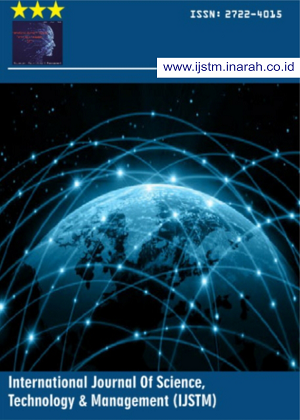Implementation of K-Means Clustering for Inventory Projection
Abstract
Inventory forecasting is crucial in effective supply chain management and cost reduction. However, traditional forecasting techniques face significant challenges due to the complexity and variability of demand patterns. This study explores the use of K-means clustering, a data-driven approach that can improve inventory forecasting accuracy. By grouping inventory items based on their unique demand profiles, we can create personalized forecasting models for each cluster. This technique enhances demand estimation, helping businesses make informed decisions and optimize their inventory. Our research delves into the use of K-means clustering to identify patterns and similarities within historical demand data. This clustering process divides inventory items into groups with similar demand characteristics. By applying specific forecasting models to each cluster, we achieve greater precision in our predictions. The proposed methodology is rigorously evaluated using real-world inventory datasets, and the results demonstrate its significant superiority in forecasting accuracy compared to conventional non-clustered methods. This study offers compelling evidence and valuable insights for practitioners seeking to improve their inventory management practices through data-driven techniques.
Downloads
References
J. V. A. Haryanto and W. Santosa, “Pengaruh Strategi Manajemen Rantai Pasok Terhadap Kinerja Operasional Pada Usaha Mikro Kecil Dan Menengah,” Sains: Jurnal Manajemen dan Bisnis, vol.15, no.1, p.63,Nov. 2022.
I. Nawangsih and R. Puspita, “Implementasi Algoritma K-Means Dalam Mengkategorikan Produk Terlaris Dan Kurang Laris Pada Toko Alfamart Cikarang,” Jurnal Pelita Teknologi, vol. 16, no. 1, pp. 79–87.
Vanessa, Lucia, Hellen Junvellen, and Meiliana Geraldin Hutagaol, “Analisis Ketersediaan Produk Terhadap Kepuasan Konsumen Berbelanja Di Maju Bersama Cabang Thamrin Plaza Medan.” [Online]. Available: https://ejurnal.eka-prasetya.ac.id/index.php/
S. S. Nagari and L. Inayati, “Implementation Of Clustering Using K-Means Method To Determine Nutritional Status,”Jurnal Biometrika dan Kependudukan,vol. 9,no.1,pp.62–68,Jun. 2020.
R. Gustriansyah, N. Suhandi, and F. Antony, “Clustering optimization in RFM analysis based on k-means,” Indonesian Journal of Electrical Engineering and Computer Science, vol. 18, no. 1, pp. 470–477, 2019.
F. Indriyani and E. Irfiani, “Clustering Data Penjualan,” 2019.
Subekti and Y. Nursyanti, “Optimasi Persediaan Dengan Pendekatan Deterministik Dinamis Pada Industri Manufaktur,” Jurnal Teknologi dan Manajemen Industri Terapan (JTMIT), vol. 2, 2023.
J. Nasir, “PENERAPAN DATA MINING CLUSTERING DALAM MENGELOMPOKAN BUKU DENGAN METODE K-MEANS,” Jurnal SIMETRIS, vol. 11, no. 2, 2020.
I. Anggriawan and W. Gunawan, “Implementation of Data Mining Using K-Means Algorithm for Bicycle Sales Prediction,” ILKOM Jurnal Ilmiah, vol. 14, no. 3, pp. 284–293, Dec. 2022.
Y. Yulianti, D. Y. Utami, and N. Hikmah, “Implementasi Data Mining Menentukan Game Android Paling Diminati Dengan Algoritma Apriori,” Paradigma - Jurnal Komputer dan Informatika, vol. 21, no. 1, pp. 29–34, Mar. 2019.
H. Suroyo, Penerapan Machine Learning dengan Aplikasi Orange Data Mining Untuk Menentukan Jenis Buah Mangga. Seminar Nasional Teknologi Komputer & Sains (SAINTEKS), 2019
T. Akhir, “Analisis Cluster Dengan Metode K-Means Pada Persebaran Kasus Covid-19 Berdasarkan Provinsi Di Indonesia.”
A. P. Joshi and B. V.Patel, “Data Preprocessing: The Techniques for Preparing Clean and Quality Data for Data Analytics Process,” Oriental journal of computer science and technology,vol. 13,no.0203,pp.78–81,Jan. 2021.
M. Zubair, M. A. Iqbal, A. Shil, M. J. M. Chowdhury, M. A. Moni, and I. H. Sarker, “An Improved K-means Clustering Algorithm Towards an Efficient Data-Driven Modeling,” Annals of Data Science, 2022.
S. Setiawan, “Analisis Cluster Menggunakan Algoritma K-Means Untuk Mengetahui Kemampuan Pegawai Dibidang It Pada Cv. Roxed Ltd,” Jurnal Pelita Informatika, vol. 7, no. 3, 2019.
Copyright (c) 2024 International Journal of Science, Technology & Management

This work is licensed under a Creative Commons Attribution-ShareAlike 4.0 International License.





























